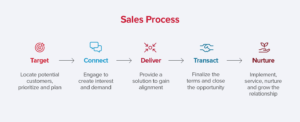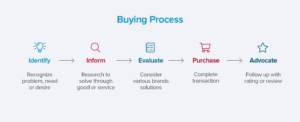This is post #7 in a 10-part series on the New B2B Marketing Paradigm.
In our last post, we discussed how to drive a consistent flow of traffic to your site through paid advertising. In this post, we’ll talk about how to how to nurture those leads and hopefully turn them into buyers.
First, let’s talk about your sales process. Here’s what it looks like at many organizations:

Notice that the language is all about what the salesperson is going to do to the prospect to get them to close—not so much about helping the customer through their buyer’s journey.
Then, on the other side of the transaction, here’s what the typical buyer’s journey looks like:

Note that the buyer’s journey mentions nothing about engaging or interacting with a salesperson. On the contrary, today’s buyer often refuses to engage with sales until they’ve had a chance to do their own research. They are wary of giving out their contact information, because they know that doing so will turn their inbox into a spam fest.
So, rather than send everyone who interacts with your website down to sales for follow-up, you’ll need to nurture that lead through the buyer’s journey until they express some form of intent to purchase. Then—and only then—you can hand them off to sales. This means instead of overwhelming someone with sales calls as soon as they give their contact information, you’re going to provide them with high-value content and earn the right to continue the conversation.
Lead nurturing should primarily be a marketing activity—not a sales one.
Lead nurturing should primarily be a marketing activity—not a sales one.
To Gate or Not to Gate? That is the Question.
This leads to a big discussion going on right now: gated vs. non-gated content. If you’re looking to make an immediate handoff to sales, your inclination is going to be to gate all content, because you need to capture that contact info. But a big ask at the very beginning of the buyer’s journey can create unnecessary friction and turn away worthwhile prospects.
Besides, today’s marketing automation platforms have gotten much better at tracking anonymous users and their behavior across multiple sessions. So it’s possible to gather valuable data even through non-gated content. Your goal should be to create an environment where the user comes back often to consume your content, making you top-of-mind when they’re ready to purchase.
So, then, why gate any content at all? The truth is sometimes you want to create some friction. Gating allows you to filter out people who are just gathering information and zero in on prospects who are ready to give you their contact information—and their attention.
Draw a line between your highly valuable content and your general content. Consider a two-thirds model, where the top third of your content (consumer reports, stat-heavy research pieces, annual reports, etc.) is gated, and the remaining two-thirds (simple articles, case studies, and infographics) are downloadable for free. This strategy will provide you with a mix of known and unknown users whom you can nurture according to interest level.
How to Nurture Unknown Contacts
So, what do you do with those folks who haven’t yet provided their contact information? There are several ways you can nurture unknown contacts. Rather than flood their inboxes, you’re going to work on establishing trust in your brand. How? By providing your potential customers with value while demonstrating respect for their time and personal space.
Here is a mix of strategies you can turn to when nurturing unknown contacts:
- Retargeting campaigns. Stay top-of-mind through display ads and social advertising in both search and website visits.
- Targeted social advertising. Upload individuals into the targeting criteria for your ads and get in front of them when they’re browsing.
- In-site personalization and targeting. Recognize returning visitors and drive them back to areas that you know are of interest to them.
In order to establish trust in your brand, you must provide your potential customers with value while demonstrating respect for their time and personal space.
How to Nurture Known Contacts
Once someone identifies an interest in your product, you can run them through a program of outbound email, social advertising and other highly targeted methods to encourage them to return. This will require creating a specific nurturing stream for each product line.
At the risk of sounding like a broken record, the key to all of this is to provide value with every interaction. Rather than pushing, pushing, pushing the call to action, your goal is to show prospects what they need to see to make an informed decision. Of course, you’re also tracking those interactions and using the data to determine when someone is “in market” and ready to reach the salesperson’s hands. We’ll talk about that next.
In the meantime, reach out if you’d like to discuss any of this on a deeper level.
